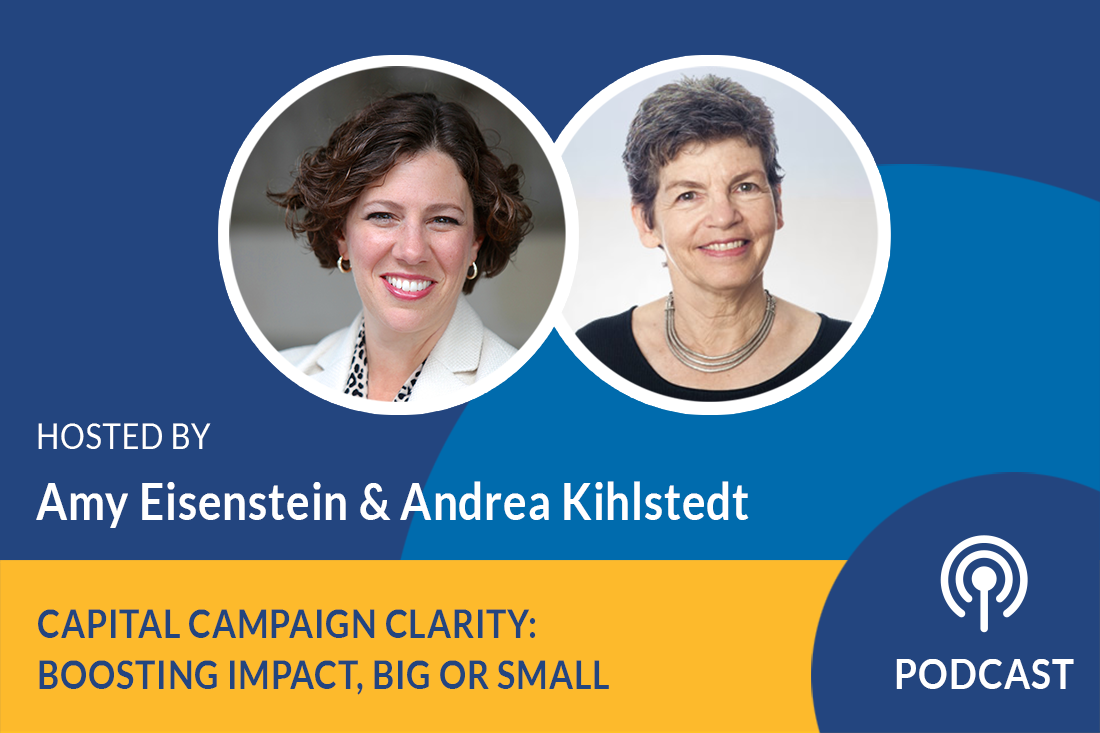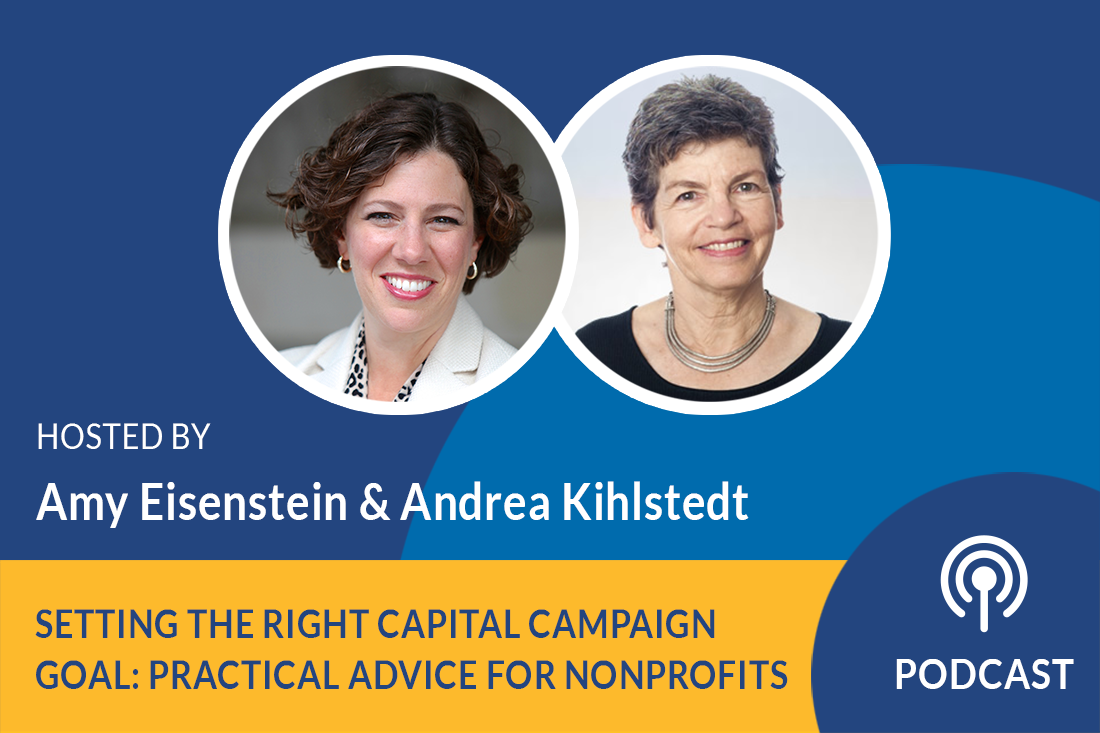Podcast: Capital Campaign Clarity: Boosting Impact, Big or Small

Season 4, Episode 22
Join fundraising experts Amy Eisenstein and Andrea Kihlstedt as they unravel the essentials of capital campaigns, from small-scale projects to multimillion-dollar transformations.
Discover why size doesn’t define a campaign’s success, but its potential to catapult your organization forward does. Through relatable stories, expert insights, and practical tips, this episode explores how campaigns differ from annual fundraising, strategies for securing transformational gifts, and the lasting benefits of building donor relationships.
Tune in for inspiring examples and practical guidance to help your organization thrive through intentional and impactful fundraising.
Listen Now:
Andrea Kihlstedt:
Does size really matter? I mean, really, can you have $100,000 campaign or a $10,000 campaign, or does your campaign have to be for a million dollars or more?
Amy Eisenstein:
Hi, I’m Amy Eisenstein. I’m here with Andrea Kihlstedt, my co-founder and collaborator and we’re talking not only about campaign size, but really what makes a capital campaign. Why and when you might think about having one, how it’s different from your annual fund.
We’ve got a whole host of topics to dive into today, and this topic was asked of us by a prospective client. And they were asking, “Is $5 million the right size for a capital campaign?” And that’s the right and the wrong question.
So, Andrea, let’s dive in.
Andrea Kihlstedt:
Yeah. What determines whether something is a capital campaign or not isn’t how many zeros there are on the goal. It is whether that the money raised is going to boost or catapult the organization into being able to do more and do it better. And whether the campaign is done capital campaign style, right, with all the various strategic approaches that we use in capital campaigns. So, let’s get into that.
2 Factors Govern Capital Campaign Success, Regardless of Size
Let me just start by saying I really did once years ago work with a young woman who needed to raise $10,000 for a project. I worked with her and we did it capital campaign style. And she raised nearly $20,000, was overjoyed, and she had had her own little capital campaign.
So, that’s an extreme example, but without raising that money, she wouldn’t have been able to accomplish something really remarkable, right? And she learned the strategy of doing a capital campaign.
So, you can have a very small campaign if you want, though, of course, most campaigns are probably a million, two million, five million and up, 20 million. So, we have a huge big range of campaign sizes. There are some things that hold them together. Let me see if I can just tick them off.
1. Capital Campaigns Raise Money to Take an Organization to the Next Level
First of all, campaigns do not raise recurring money for annual fundraising. The money that a capital campaign raises is money that is raised to do something special. Money that is raised for your annual fundraising is recurring money.
Money where you predictably go back to donors year after year after year for gifts to help your organization stay afloat, stay alive, pay the bills. Campaigns are something over and above that. So that’s number one.
2. A Few Very Large Gifts Make Capital Campaigns Work
Number two, campaigns typically rely on a relatively few donors to give a large percentage of the campaign goal. So, we often talk about needing 20 gifts to raise about 70% of your campaign goal, and that’s a standard strategy for capital campaigns. In campaigns, we don’t go broad as you often do with your annual fund.
So, the first thing is a campaign is going to jet-propel your organization to do more. And the second thing is you’re looking for a relatively few large gifts to make your campaign work. Now, what are the other characteristics, Amy?
Amy Eisenstein:
Well, I think I want to go back to this idea about one-time special gifts that have long-term impact. So, we started joking about the size of a campaign and size doesn’t matter, but generally, when we’re talking about a capital campaign, it is as you described, to have a springboard effect or to catapult the organization. And so you’re asking, as you said, these big donors at first to make one-time special gifts that are going to have long-term impact.
An Example: An Animal Shelter Needs Much More Space
So, let’s give an example of an animal shelter. We actually work with lots of animal shelters. There’s a specific humane society that I’m thinking about, and they are adding a spay, a neuter clinic in addition to a special wing, an additional wing for dogs, because they just have so many animals that they drastically need more space.
So, in one sense, they will need more annual fund revenue moving forward to continue to operate this expansion, this spay and neuter clinic and this additional wing for dogs. But first, in order to get there, they’re going to need a serious boost in revenue to build, the construction, the renovation, the expansion.
And so that’s what we’re talking about here. Whether it’s a little bitty amount of money or multimillion dollars over several years, it’s transformational for the organization, for the community. I mean, I think that that’s the important point that we’re trying to make here.
Andrea Kihlstedt:
Yeah, the other thing to think about as we talk about relying on a relatively few gifts is that chances are very good that your campaign will rely on the very same donors who give you annual fund gifts year in and year out.
That money’s not going to come from some strange place that you’ve never heard of before. It’s going to come from the people with whom you’ve built a strong relationship over time. But you’re going to be going to them and saying:
“Listen, we have an opportunity for a gift to be transformational.”
That’s a good word, Amy. I like it.
So, you’re going to be going in large part to the very same donors you go to for your annual fund, but you’re going to be saying to them:
“We are after a special gift to do something extraordinary that’s going to enable us to accomplish much more about this topic, this subject, this mission that you care deeply about.”
That’s campaign think, right? That’s the way we consider campaigns.
Capital Campaigns Actually Help Annual Funds Grow
Amy Eisenstein:
Right. And the good news is that most organizations at the end of the campaign are able to raise more for their annual fund, for their expanded programs, projects, services because of a couple of reasons.
One, a really good campaign actually strengthens your fundraising abilities, capabilities, technology, infrastructure, staff, skills and confidence. So a great multi-year campaign process enhances the fundraising, builds capacity, if you will, at your organization for fundraising.
And, I think, that that’s a big concern of lots of people heading into a campaign. If we seriously expand our programs and services, we will need to raise more on an ongoing basis. And, I think, it’s important at the beginning of a campaign to start explaining to all your donors and every conversation you have with donors, what the difference is, how the organization will look moving forward, what their role will be.
And the exciting news is that in this year’s benchmark research report that we did recently, we found that nearly 80% of organizations are able to continue to maintain their annual fund and or increase it during and after a campaign.
If you want those research results, head over to capitalcampaignpro.com slash /research and you can download the results and check them out for yourself. We’ve been a little windy here today. Where do you want to go next?
Andrea Kihlstedt:
That’s okay. That’s all right. It may seem, I think, counterintuitive that you’re able to run your annual operating fund at the same time that you’re doing a capital campaign. And I think there are a lot of people who think:
“Oh my, how can we be going to the same people again?”
They’re embarrassed by it.
“That we know donor so-and-so gives us such a generous gift every year. They give us $10,000 a year for our annual fundraising every year. How can we go to them to ask them for a campaign gift when they’re so generous with their annual support?”
And the reality is that people who are giving you significant gifts to your annual revenue, annual support, do so because they care deeply about what you do. They would not feel happy if you didn’t come to them to talk to them about the new project you were doing to expand your services, to do a spay-neuter clinic, to add a new wing.
They would want you to come to them early and talk about doing that and if they were able, they would probably be happy to support that. So, when you feel yourself embarrassed to go and ask someone or invite them to give a bigger gift, you have to understand that that’s a limiter.
Your own anxiety about that may well limit your ability to have a successful campaign. And you have to really work on your mindset that it’s the very people who give you generously annually who are going to want to help you expand and extend the work you do in that particular mission.
Amy Eisenstein:
I think that’s such an important point. And just a quick reminder, most people, most donors make annual donations from their checkbook, right? From cash flow giving, from their credit card, and that’s probably not where they’re going to give a substantial capital gift from.
And so you can even think about and talk with them about how people make capital campaign gifts from assets, from stock, from retirement funds, from property, from other types of assets that wouldn’t come from checkbook giving or a credit card gift because that is limiting.
Most people don’t keep six figures, seven figures in their checking accounts. And so helping donors think through where they might consider giving a gift of that magnitude, they may never have considered that before, and you’re helping them think about how they could be more generous.
Andrea Kihlstedt:
It can be so exciting to give to a special project, to give to something that’s very specific. That when the organization comes to you and says:
“We are doing a mobile unit, a mobile spay-neuter clinic that’s going to go scurrying around the neighborhoods in our community. And in order to do that, we have to raise $500,000.”
I don’t know what it would cost. I’m making that up. But…
“We have to raise a certain amount of money and we would love for you to give a lead gift to get us going on that project.”
For many donors, that’s much more exciting than when they get your solicitation saying, “What wonderful work we do. Thank you for your help. Won’t you give us again at the end of this year?” I mean, you could even tell as I talk about it, what a difference it makes for a donor to be asked to play a leadership role in something significant that’s going to move the needle on how the organization is doing its work.
Keep the Focus on the Mission, Not the Money
So your job, our job in this field, in the fundraising field is not to worry about the money. It’s to be thinking about the mission and the people who care about the mission and giving them opportunities to help us do much more. When we do that, then we find there are people who are really happy to give bigger gifts to our capital campaigns.
Now, Amy, there are a couple of other things I want to talk about. So, one is that when an organization has a successful capital campaign and someone who gives a regular annual fund, gift, and then they give a special, much bigger gift to the capital campaign, through that process, they start to think about the organization differently.
They start to think about their giving to the organization differently, and they may well over time boost their annual fundraising to their annual funding of the organization because they’ve given a million, a half a million, a quarter of a million dollars, not just a thousand dollars in their annual fund.
So many campaigns raise the entire level of giving simply because they are talking to donors and asking them for much larger gifts. And it feels peculiar really for a donor then to go back eventually to giving only a thousand dollars, right?
So you may see it as not only a springboard to moving the mission of the organization forward, but a springboard to moving the entire fundraising program forward as you start talking to donors about giving larger gifts. So-
Amy Eisenstein:
All right. So let’s… Oh, do you have another point you wanted to make?
Andrea Kihlstedt:
No.
Final Thoughts
Before we end, I want to talk about having little campaigns during the year, which you could also do.
Amy Eisenstein:
Okay. Well, I think to bring this full circle, we started with the idea of campaign size, right, and so one of the questions that came up, and just in case listeners are interested in joining us, we do a monthly Q&A session we call Campaign Conversations. So that’s how this question came up a couple weeks back.
If you want to join us, just visit capitalcampaignpro.com and go to our resources tab, and it’s a free drop-in Q&A session that we hold every month. We’re happy to have you join us and ask your questions. But we were talking about campaign sizes, $5 million a campaign, there’s $100,000 a campaign, and I think the answer is yes, right?
Do you have a specific project program thing that you need to raise money for that’s not a recurring expense that will catapult your organization? I mean, one good little example is something like a school bus. You buy it once. You use it for five or 10 years. I mean, of course you have to fill it with gas, but I think that’s not the point.
The point is that that really enables you to do expanded programs and services because you need this school bus to transport the kids that you’re working with. And so you could do a little mini campaign. I don’t know how much school buses cost $150,000.
You could do a little mini campaign that’s not part of your annual fund, but is a specific ask to donors over and above their regular annual fund gift for a special project or program or school bus. Or you could think of this as a hundred million dollars effort that really is going to also transform your community in specific in certain ways.
Andrea Kihlstedt:
Amy, I like the idea of an organization having littler campaigns between big campaigns. Typically, organizations do a big campaign, a building campaign every 10, 15, 20 years, usually not more often than that. But in between times you can do a smaller campaign. Significantly smaller to accomplish something specific.
And in doing that, again, you have this opportunity to get donors to think differently about their giving to you and to become more excited about opportunities you have for them as donors. So don’t let that go past, right? These little campaigns are run the same way a big campaign is run just on a much smaller, shorter timeframe.
And once again, it gives you an opportunity to go to some of your largest donors and ask them for help with this half million dollar campaign that you might do every second year or something like that for something special. So, I think that’s a really nice pattern.
I mean, just to summarize, let’s say every 15 years you do a 20 million campaign to do something really significant, and maybe you have three smaller campaigns for a quarter of a million or a half a million dollars in the interim years. Both to pay for something special for the institution and to motivate your donors to give more. I like that model.
Amy Eisenstein:
Yeah, I think it’s great. It’s great practice. It’s great experience to go talk to your donors about a special project or program. I mean, fundraisers, aren’t you always looking for something concrete and tangible and specific to talk to your donors about? And it will help give you language to distinguish from the annual fund needs from your special needs.
So, I think it’s a great excuse, great reason to go out and talk to all of your donors on a regular and ongoing basis.
So, great. Andrea, as always, I think hopefully listeners have learned something and they’ll come back week after week and we’ll see you soon.



This information was extremly helpful. I expecially appreciate the clarity and explanations of the different ideas and concepts relating to large verses small campaigns.